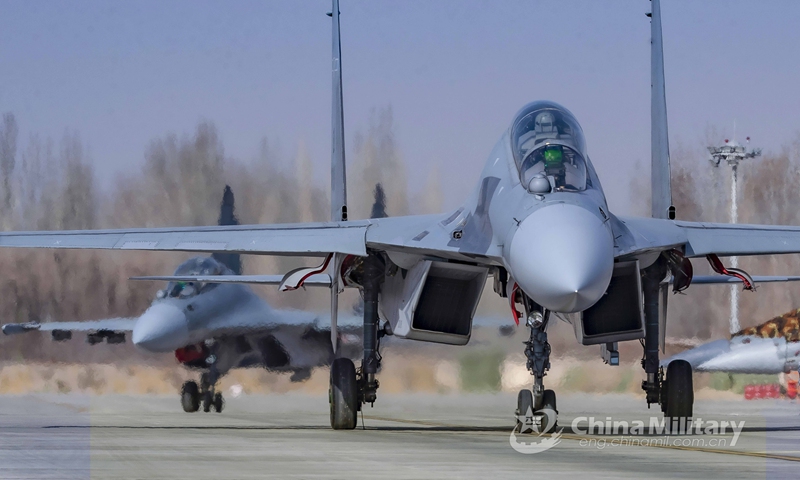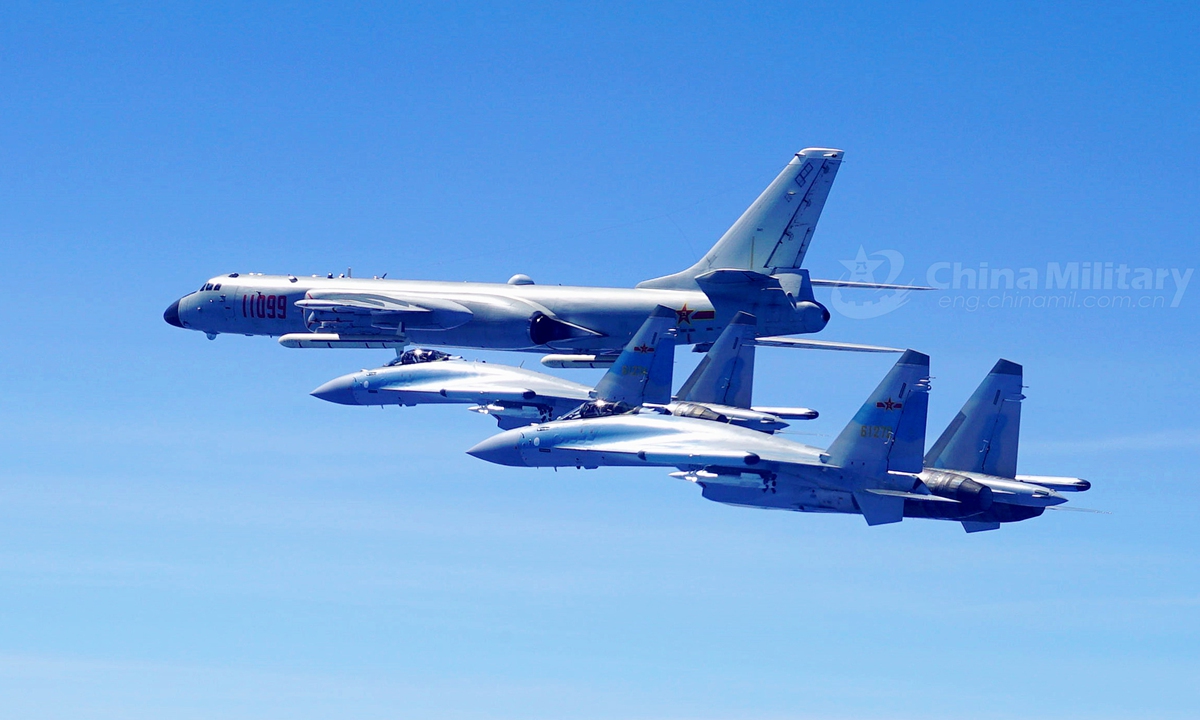
J-16 fighter jets attached to an aviation brigade of the air force under the PLA Western Theater Command taxi on the runway during an aerial combat training exercise under complex electromagnetic conditions in early April, 2021.(Photo: eng.chinamil.com.cn)
While the people of the Chinese mainland have been celebrating the October 1 National Day and enjoying the weeklong national holidays, the People's Liberation Army (PLA) has conducted massive military actions in the airspace near the island of Taiwan to deter secessionism and foreign forces, especially the US, who support the secessionist authorities in the island, and the latest remarks made by US senior officials and the secessionist Taiwan authorities showed that the tensions are unlikely to ease.
The secessionist Democratic Progressive Party (DPP) authority on the island have realized the danger but failed to correct their mistakes, and even strengthened their connection and military cooperation with foreign forces to seek secessionism, as Tsai Ing-wen, the regional leader of the island, on Thursday told visiting Western politicians to the island that her authorities will seek to work with other "like-minded democracies," Reuters reported on Thursday.
Chinese mainland experts warned that the DPP authority's move to seek secessionism and support from the US and its allies are the reasons why regional peace and stability are damaged, and Tsai's attempt will only prompt tougher and heavier responses from the mainland and even speed up the process of China's national reunification.
On Tuesday, US Navy Secretary Carlos Del Toro said the US will release a strategic guidance document this week outlining how the US Navy and US Marine Corps will maintain maritime dominance globally to contain China, even to deter the Chinese mainland from reunifying Taiwan, according to Defense News, a US media outlet on global defense information.
Lü Xiang, an expert on US studies and research fellow at the Chinese Academy of Social Sciences, said Taiwan is no longer "a 'card' that could be played only by the US" to pressure China, as the mainland can also effectively counter US provocations in the region by undertaking massive military actions around the island.
If the US does not want to see peace and stability impacted in the region, it should never use the island of Taiwan as a card to pressure China, and now Washington has realized the PLA has overwhelming strength to counter its acts, and its wrongdoing of making use of Taiwan has brought concerns to itself, Lü told the Global Times on Thursday.
It is impossible for any foreign force to deter or stop the process of China's reunification as the mainland is determined to crack down on all kinds of foreign intervention and capable of doing so, and could reunify the island by force if necessary, Yuan Zheng, deputy director of the Institute of American Studies at the Chinese Academy of Social Sciences, told the Global Times on Thursday.
"The only thing that matters for the US and its allies is that how big a price they want to pay to test China's strength and determination on this matter," Yuan noted.

Two Su-35 fighter jets and a H-6K bomber fly in formation on May 11, 2018. The People's Liberation Army (PLA) air force conducted patrol training over China's island of Taiwan on Friday. Su-35 fighter jets flew over the Bashi Channel in formation with the H-6Ks for the first time, which marks a new breakthrough in island patrol patterns, said Shen Jinke, spokesperson for the PLA air force.Photo:China Military
Massive actions
Over the past week, since October 1, the PLA consecutively held military drills near the island of Taiwan, dispatching a whopping 150 warplanes of different types to the region, breaking records in terms of exercise scale three times in the process.
On the October 1, first day of the National Day holidays, breaking the previous record of 28 that was set in June, 38 PLA aircraft entered the island of Taiwan's self-proclaimed southwest air defense identification zone, with many also circling to the southeast side of the island, before returning to the mainland, according to press releases the defense authorities on the island published on the day.
Saturday witnessed 39 PLA warplanes active near the island, refreshing the record only one day after it was set.
After 16 PLA aircraft approached the island on Sunday, which was not even surprising by then, 56 came on Monday, again breaking the record in the number of PLA aircraft dispatched for drills near the island of Taiwan in a single day.
PLA drills seemed to have taken a pause after that, with only one aircraft edging near the island on Tuesday, and none on Wednesday, according to the island's defense authorities.
In these exercises, the PLA sent many different types of aircraft, including fighter jets, bombers, early warning aircraft and anti-submarine warfare aircraft, and they operated during not only days, but also nights.
The participation of anti-submarine warfare aircraft indicates that the PLA must have dispatched not only aerial forces, but also maritime forces in joint tasks, analysts said.
In one week alone, the PLA has sent at least 150 aircraft near the island of Taiwan, making the total number in 2021 as of early October surpassing 600, compared to about 380 in the entire 2020 and about 10 in 2019, a media outlet on the island said on Wednesday.
The frequent appearances of PLA aircraft during the National Day holidays around Taiwan island came with the Taiwan authority's more and more obvious intention to seek "Taiwan independence" and other hostile moves against the Chinese mainland, said Li Fei, a professor with the Taiwan Research Institute at Xiamen University.
"It is clear that the PLA's actions are aimed to warn Taiwan secessionists as well as the Western forces behind them, demonstrating to them the mainland's determination and capacity to reunite the country," Li said.
The above-mentioned PLA drills came at a time when the US, the UK, Japan, the Netherlands, Canada and New Zealand recently held multinational joint naval drills in the Philippines Sea involving three aircraft carriers, the USS
Carl Vinson, the USS
Ronald Reagan and the HMS
Queen Elizabeth, with many of the warships entering the South China Sea through the Bashi Channel, located to the south of Taiwan island, during the time period, according to monitoring made by the South China Sea Strategic Situation Probing Initiative, a Beijing-based think tank.
US Secretary of State Antony Blinken also said on Sunday in an interview with NBC that the US is concerned about the Chinese mainland's "aggressive actions against Taiwan" and warned it would be a "serious mistake" for "anyone to try to change the status quo in the Western Pacific by force."
Chinese mainland experts said that the PLA's move is in response to provocative military acts made by the US and its allies that had seriously threatened China's sovereignty and national security, so accusing China of changing the status quo in the region is nonsense, because the US and the DPP authority are the ones to be blamed for changing the status quo.
Danger closeTaiwan's defense authorities said in a report that by 2025, the PLA will gain the complete capability of area denial and anti-access, blockading the surroundings of the island, thanks to the commissioning of aircraft carriers, Type 09III nuclear-powered attack submarines, Type 055 large destroyers and Y-20U aerial tankers, CNA reported, noting that the new Type 075 amphibious assault ships are significantly boosting the PLA's landing capabilities from multiple points around the island, "posing great challenge to the island's defense."
In an attempt to counter the PLA, Taiwan's defense authorities on Tuesday submitted a draft proposal of an extra military spending of NT$240 billion ($8.6 billion) over the next five years, and the spending will go mostly toward naval weapons, including missiles and warships, Reuters reported.
Among the weapons, the Hsiung Sheng land-attack missile, with a range of 1,200 kilometers, is said to be capable of hitting targets in the Chinese mainland, Taipei-based newspaper Liberty Times reported on Wednesday.
While Taiwan's missiles could be potential threats to the Chinese mainland, they are technologically lackluster, Chinese mainland analysts said.
Song Zhongping, a Chinese mainland military expert and TV commentator, told the Global Times on Thursday that the Hsiung Sheng is a subsonic cruise missile that uses traditional guidance systems, and this means it has slow speed and limited defense penetration capabilities, leading to little threat, if any, to the PLA.
The PLA can easily intercept the missiles with sea-based, air-based or land-based air defense systems, Song said, noting that the PLA can destroy their launch positions even before they are launched, or use electronic jamming to make them lose their targets.
That the island of Taiwan's attempts to resist reunification by force cannot succeed, and no matter what weapons the Taiwan secessionists make or buy, they cannot change the fact that the PLA has overwhelming advantages in the Taiwan Straits and surrounding areas, analysts said, stressing that once the mainland decides to solve the Taiwan question by force, no weapon can deter the unshakable determination of 1.4 billion people to realize national reunification.





